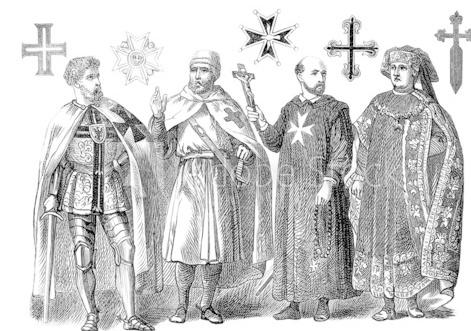The article by De La Riviere of February 2017 referred to the claim that the Chevalier Ramsay made in his speech of 1736 to the Grand Lodge of France in Paris, that the Freemasons descended from the Knights Templar. Many eminent Freemasons share such perception and historians concur that the roots of Freemasonry date back to the Crusades.
It is a myth to say that The Crusades were military expeditions aimed at defending the Catholic faith; greed was also a big incentive. The unwritten law of succession of the time seriously penalised the junior male offsprings from noble marriages; they could inherit neither the family title nor the family’s wealth. They needed to look outside their kingdom’s borders for richness , power and glory and saw the Crusades as a befitting façade to hide their desire for worldly gains.
The instigator of the first Crusade was Pope Urban II  who had summoned the Council of Clermont, France, in 1095 and called for a war which had the intent of reclaiming the Holy Lands from the Muslims. Hundreds of minor princes, knights, vassals and tens of thousands of ordinary people took part in the Holy Wars, each with his own plan: the French knights wanted more land, the Italian merchants sought to add another good commercial opportunity to their portfolio, the common soldiers dreamed for glory and the peasants longed for freedom from the miserly life to which they had been doomed back home.
who had summoned the Council of Clermont, France, in 1095 and called for a war which had the intent of reclaiming the Holy Lands from the Muslims. Hundreds of minor princes, knights, vassals and tens of thousands of ordinary people took part in the Holy Wars, each with his own plan: the French knights wanted more land, the Italian merchants sought to add another good commercial opportunity to their portfolio, the common soldiers dreamed for glory and the peasants longed for freedom from the miserly life to which they had been doomed back home.
When after months of travel by sea, foot and horse, the Crusaders reached Jerusalem it was the year 1099. They put the city under siege and five weeks later entered it as the conquerors, plundering everything and massacring every one in their way. It is reported that in two days the Crusaders killed some 40,000 souls between Muslims and Jews. They then elected Jerusalem as their capital and founded a Kingdom that stretched from Palestine to Antioch.
The Crusaders then began to organise themselves in a way that would efficiently support the new States they had founded. They established military orders which have remained unique in history; among such Orders there was one that has fascinated people down the centuries: the Order of the Knights Templar.
THE WARRIOR MONKS
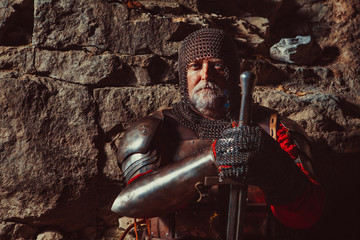 The full name of that Order was: “The Poor Fellow-Soldiers of Jesus Christ and the Temple of Solomon” and it was founded by two French knights – Hugh de Payens and Godfrey de St Omer- some twenty years after Jerusalem had been ransacked.
The full name of that Order was: “The Poor Fellow-Soldiers of Jesus Christ and the Temple of Solomon” and it was founded by two French knights – Hugh de Payens and Godfrey de St Omer- some twenty years after Jerusalem had been ransacked.
Their connection with Solomon was the mount onto which the old King of Jerusalem’s temple once stood and which had became the Templars’s headquarters. King Baldwin I – a Frenchman from Boulogne and brother of Godfrey of Bouillon, the first Crusader ruler of Jerusalem – had bestowed the Knights a wing of his palace. And as such palace had been built right next to King Solomon Temple’s ruins, the Knights became known as the “Knights of the Temple” or Templars.
They Templars became bankers and lent money to merchants and Kings, exchanged currencies, bought land, built castles and churches and amassed a great deal of wealth. Having first established themselves as men of excellent military skill , they no longer needed to live on the rewards received for protecting the thousands of pilgrims and merchants who come to the Holy Lands from all parts of Europe. They therefore became the rightful and sole intermediaries in just about all things taking place between the West and the Orient.
Eventually in 1187 the Crusaders lost Jerusalem to the Muslims and were killed in reiteration for their earlier massacres; those who managed to escape death
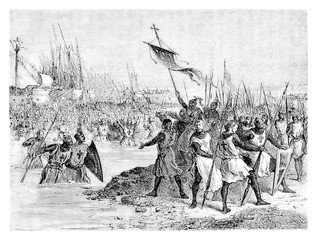
fled to Europe where they continued silently to prosper financially and regain power. The majority settled in France and in particular in the southern region of Provence. But, decades later ,their activity of money lending to the Royal family led King Philip (le Bel) to become highly indebted. Fearful of losing control of his Kingdom, the monarch decided to arrest all the members of the Order with the aim of seizing their hidden fabulous treasure. But the raid of 1307 in Paris did not return the expected results : the underground city vaults in which the treasure was believed to have been stored were found almost empty!
It was now time for Pope Clement V to join in the arena and continue the purge King Philip had started. He accused the Knights of heretism and brought them in front of the Inquisition Tribunals.
The Grand Master of the Order – Jacques de Molay – was publicly burnt at the stake in Paris in 1314.
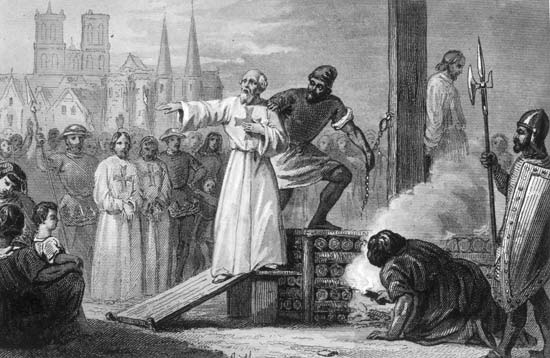
Thereafter , the Templars dispersed throughout Europe – perhaps even sailed the Atlantic! – and went underground.
Having been labelled “heretics” by Rome, the survivors of the suppression could only find shelter in Kingdoms which did not recognise the authority of the Catholic Church and under the ruling of King Robert the Bruce, Scotland was indeed one of those anticlerical states. When the knights arrived in Alba[1] , they schemed a convenient way to disguise themselves: they infiltrated the operative Lodges of the bricklayers and passed themselves for operative masons. This dualism of “knight-builder” is exactly what the Chevalier Ramsay was referring to in his speech when he said:
“(…) The word FM must not be taken in a literal (…) and material sense as if our founders had been simple workers in stone or merely curious geniuses who wanted to perfect the Arts. They were not only skilful architects (…) but also religious and warrior Princes who designed, edified and protected the living Temples of the Most High. And (…) whilst they handled the trowel and mortar with one hand, in the other they held the sword and the buckler.
The Templars were thus able to survive, maintain alive their rituals and perpetrate their philosophy through the foundation of the Masonic Scottish Rite. It is interesting to note that the name of the leader of those Templars who had taken refuge in Scotland was Mabeignac and that his name was later changed to the more Scottish sounding “Mac Benach” , probably to more easily obtain access into the builders’ Craft. The speculative Freemasons are familiar with this name as it is mentioned in the Ritual.
WHY DID THE TEMPLARS ABANDONED CHRISTIANITY ?
During their time in Jerusalem the Templars are said to have adopted a number of strange and mystical doctrines. It would seem that the Order was influenced by some “secrets” it had discovered , resulting in the Knights abandoning Christianity.
What could those secrets be?
Were they the stolen ancient Egyptian teachings included in the Kabala, whose rituals are often associated with Magic? Was it the occult information that only Pharaohs possessed? It may be possible given that the Temple of King Solomon itself contains some of the mathematical secrets also known to the Ancient Egyptians!
The authors of the book “The Hiram Key” [2] 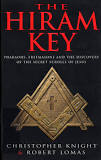 state that there is definitely proof of a great deal of excavation been made under King Solomon’s Temple which predates any investigation undertaken in recent history. The “Hiram Key” authors put forward the theory that the Templars must have discovered something under the Temple that completely changed their view of the world and of history.
state that there is definitely proof of a great deal of excavation been made under King Solomon’s Temple which predates any investigation undertaken in recent history. The “Hiram Key” authors put forward the theory that the Templars must have discovered something under the Temple that completely changed their view of the world and of history.
This theory appears to have been accepted even by the famous Italian novelist and past Worshipful Master of the Order Umberto Eco[3] , author of “The Name of the Rose” and other similar bestsellers. In his book “Foucault’s Pendulum”, he hints that some prominent Jews had learnt those secrets during their permanence in Egypt, had stolen them and included them in the Old Testament. He wrote: “(…) The secret (of the Temple) is known only by a small group of Rabbis who remained in Palestine (…) and from them the Templars learnt it”.
The authors of the “Hiram Key” explain that the Egyptians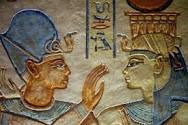 never believed in the miracle of the creation; they thought that the Universe had originated from Chaos which began to evolve only by accident. And that what we witness in our daily life is simply a war between the forces of Chaos and of Order.
never believed in the miracle of the creation; they thought that the Universe had originated from Chaos which began to evolve only by accident. And that what we witness in our daily life is simply a war between the forces of Chaos and of Order.
By learning and adopting that Egyptian-Kabalist doctrine, shared by the Jews, the Templars clearly embarked on an irreversible conflict with the Catholic Church. They sealed their own fate!
THE BIRTH OF THE SCOTTISH RITE
The Scottish King who had welcome the Templars on his land allowed them to freely continue exercise their doctrine and to greatly influence the future Masonic Lodges of his Realm.
Many years later, some of the Scottish Templars and their brethren returned to France and established there “The Masonic Scottish Rite” , recognised by all as the oldest Rite in Freemasonry.
by Aldo Reno
The author forbids any reproduction or publication of this article, in full or in part, without his explicit authorisation.
[1] Gaelic word for Scotland
[2] Christopher Knights and Robert Lomas
[3] Umberto Eco: This eminent Freemason and University Lecturer , in 2016 passed to the Grand Lodge above
Sources: Global Freemasonry by H. Yahya ; The Hiram Key by Christopher Knights and Robert Lomas ; Foucault’s Pendulum by Umberto Eco
- His Majesty’s Servant , David Garrick Esq – Freemason ? - June 7, 2024
- Influencia de la Masonería en Chile - April 29, 2024
- Pomegranate in Freemasonry – its significance - March 11, 2024

